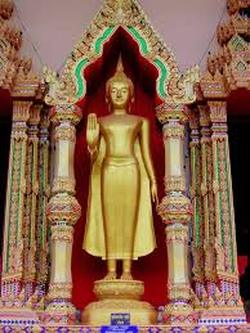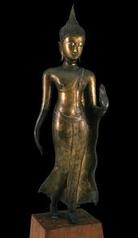Mudra
Rev. Jnana – Zen Dharma Teacher
International Buddhist Meditation Center (IBMC)
A mudra is a symbolic or ritual gesture in Hinduism and Buddhism.While some mudras involve the entire body, most are performed with the hands and fingers. A mudrā is a spiritual gesture and an energetic seal of authenticity employed in the iconography and spiritual practice of indian, southeast and east religions and traditions and of Dharma and Taoism.
Buddhas and bodhisattvas often are depicted in Buddhist art with stylized hand (mudra). The word "mudra" is Sanskrit for "seal" or "sign," and each mudra has a specific meaning often connected with a particular moment of the life of the Buddha. Buddhists sometimes use these symbolic gestures during rituals and meditation.
These are the nine principal mudras in the buddhist art:
Rev. Jnana – Zen Dharma Teacher
International Buddhist Meditation Center (IBMC)
A mudra is a symbolic or ritual gesture in Hinduism and Buddhism.While some mudras involve the entire body, most are performed with the hands and fingers. A mudrā is a spiritual gesture and an energetic seal of authenticity employed in the iconography and spiritual practice of indian, southeast and east religions and traditions and of Dharma and Taoism.
Buddhas and bodhisattvas often are depicted in Buddhist art with stylized hand (mudra). The word "mudra" is Sanskrit for "seal" or "sign," and each mudra has a specific meaning often connected with a particular moment of the life of the Buddha. Buddhists sometimes use these symbolic gestures during rituals and meditation.
These are the nine principal mudras in the buddhist art:
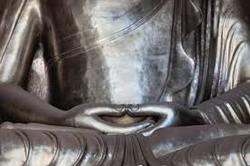
1: Dhyana mudra (Gesture of Meditation)
The first mudra is universally peculiar to seated statues. It is represented by the Buddha figure on the altar here in the Zendo. This is the mudra of meditation, of concentration on the Good Law, of the attainment of spiritual perfection, of bodhi, or awakening.
In this mudra, the back of the right hand rests on the palm of the other in such a way the tips of the thumbs lightly touch one another. The hands rest in the lap. The right hand, resting on top, symbolizes the state of enlightenment; the other hand, resting below, the world of appearance. This gesture expresses overcoming the world of appearance through enlightenment, as well as the enlightened state of mind for which samsara and nirvana are one. The position of the hands in this mudra derives, in accordance with the tradition, from the attitude, which the historical Buddha assumed, when he devoted himself to final meditation under the bodhi tree. This is the attitude he was found in when the demon armies of Mara attacked him. He was to alter it only when he called the earth to witness, at the moment of his triumph over the demons.
The first mudra is universally peculiar to seated statues. It is represented by the Buddha figure on the altar here in the Zendo. This is the mudra of meditation, of concentration on the Good Law, of the attainment of spiritual perfection, of bodhi, or awakening.
In this mudra, the back of the right hand rests on the palm of the other in such a way the tips of the thumbs lightly touch one another. The hands rest in the lap. The right hand, resting on top, symbolizes the state of enlightenment; the other hand, resting below, the world of appearance. This gesture expresses overcoming the world of appearance through enlightenment, as well as the enlightened state of mind for which samsara and nirvana are one. The position of the hands in this mudra derives, in accordance with the tradition, from the attitude, which the historical Buddha assumed, when he devoted himself to final meditation under the bodhi tree. This is the attitude he was found in when the demon armies of Mara attacked him. He was to alter it only when he called the earth to witness, at the moment of his triumph over the demons.
2: Bhumisparsa Mudra (Gesture of Touching the Earth)
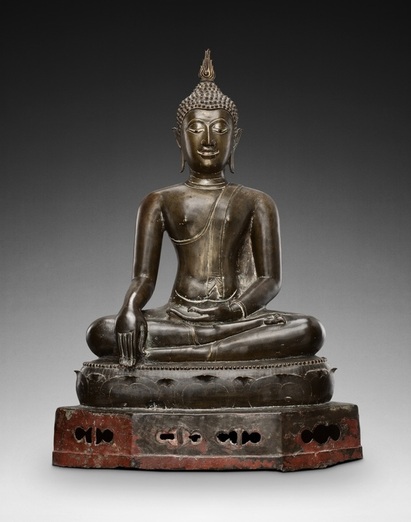
This mudra also is peculiar to seated statues. The left hand rests palm upward in the lap: the right hand, hanging over the knee, palm inward, points to the earth.
The mudra portrays the Buddha taking the earth as witness to his right to the bodhi throne, witnessing the fact that Shakyamuni has fulfilled the complete discipline and duty of a Bodhisattva. Shakyamuni’s instantaneous transformation from a Bodhisattva to the Buddha recalls the superiority of the knowledge of the Buddha, which is pure bodhi perception and the means that enables the Enlightened One to triumph over the demons.
The mudra portrays the Buddha taking the earth as witness to his right to the bodhi throne, witnessing the fact that Shakyamuni has fulfilled the complete discipline and duty of a Bodhisattva. Shakyamuni’s instantaneous transformation from a Bodhisattva to the Buddha recalls the superiority of the knowledge of the Buddha, which is pure bodhi perception and the means that enables the Enlightened One to triumph over the demons.
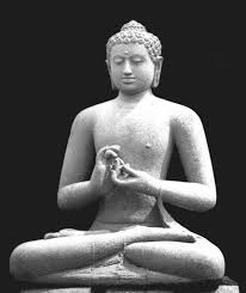
3: Dharmacakra Mudra (Gesture of Turning the Wheel of the Law)
The mudra is especially characterized by a variety of forms, even in India. Generally speaking, the right hand is held at the level of the breast, palm facing outward, while the index finger and the thumb, join at the tips to form the mystic circle, touch the joined index and thumb of the left hand, whose palm is turned inward. It symbolizes one of the most important moments in the life of the Buddha, the occasion when he preached to his former companions the first sermon after his Enlightenment, in the Deer Park in Sarnath.
Making explicit reference to the wheel as it does, this mudra is particularly steeped in the rich and ancient symbolism of the wheel in Buddhist metaphysics. Apart from the Buddha Gautama, only Maitreya (the Buddha of the future) can, as a dispenser of the Law, form this mudra.
The mudra is especially characterized by a variety of forms, even in India. Generally speaking, the right hand is held at the level of the breast, palm facing outward, while the index finger and the thumb, join at the tips to form the mystic circle, touch the joined index and thumb of the left hand, whose palm is turned inward. It symbolizes one of the most important moments in the life of the Buddha, the occasion when he preached to his former companions the first sermon after his Enlightenment, in the Deer Park in Sarnath.
Making explicit reference to the wheel as it does, this mudra is particularly steeped in the rich and ancient symbolism of the wheel in Buddhist metaphysics. Apart from the Buddha Gautama, only Maitreya (the Buddha of the future) can, as a dispenser of the Law, form this mudra.
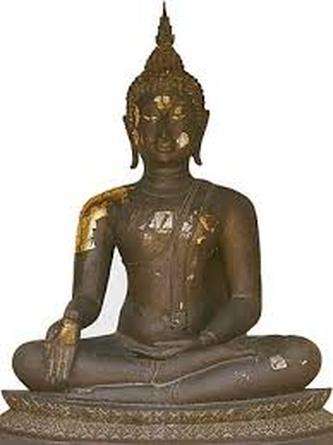
5: Varada Mudra (Gesture of Granting Wishes)
The charity of the Buddha is indicated by this mudra, as it is the gesture of dispensing favors. In this symbolism the right hand is directed downward. The palm should be completely exposed to the spectator, open and empty; the fingers may be slightly bent as if to support a round object. When the personage who makes this gesture is standing, he holds is arm slightly extended to the front. In seated statues, the hand remains at about breast level, a little to the side, the palm up; very often the other hand holds a corner of the kesa.
As noted above, this mudra symbolizes offering, giving, welcome, charity, compassion and sincerity. It is the mudra of the accomplishment of the wish to devote oneself to human salvation. The open hand, the extended fingers, symbolize the flowering of the Buddha’s Gift of Truth.
The Varada Mudra is frequently seen combined with the Abhaya Mudra, in which instance the right hand makes the gesture of fearlessness, the left that of wish granting. Standing Buddha figures are often shown in this posture.
The charity of the Buddha is indicated by this mudra, as it is the gesture of dispensing favors. In this symbolism the right hand is directed downward. The palm should be completely exposed to the spectator, open and empty; the fingers may be slightly bent as if to support a round object. When the personage who makes this gesture is standing, he holds is arm slightly extended to the front. In seated statues, the hand remains at about breast level, a little to the side, the palm up; very often the other hand holds a corner of the kesa.
As noted above, this mudra symbolizes offering, giving, welcome, charity, compassion and sincerity. It is the mudra of the accomplishment of the wish to devote oneself to human salvation. The open hand, the extended fingers, symbolize the flowering of the Buddha’s Gift of Truth.
The Varada Mudra is frequently seen combined with the Abhaya Mudra, in which instance the right hand makes the gesture of fearlessness, the left that of wish granting. Standing Buddha figures are often shown in this posture.
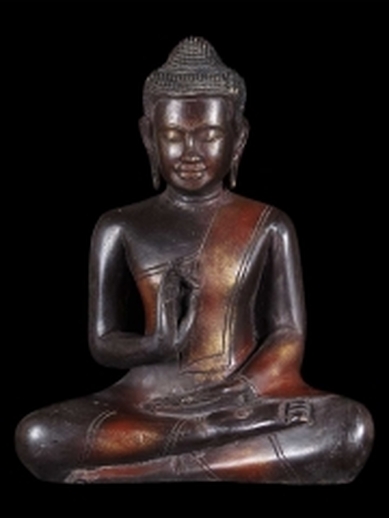
6: Vitarka Mudra (Teaching Gesture)
Here, this mudra is also a universal sign outside of its Buddhist context, especially as witnessed by its frequent appearance in Christian iconography. Both hands are in Abhaya and Varada poses, but with the thumbs touching the tips of the forefingers. The right hand is at shoulder level, the left at the level of the hips.
This mudra is mainly used for images of the Great Buddhas, and symbolizes one of the phases of the preaching of the Buddha, that of discussion or teaching of the dharma. The circle formed by the thumb and the index, a complete form, having neither beginning nor end, is that of perfection; it resembles the Law of the Buddha, which is perfect and eternal.
Here, this mudra is also a universal sign outside of its Buddhist context, especially as witnessed by its frequent appearance in Christian iconography. Both hands are in Abhaya and Varada poses, but with the thumbs touching the tips of the forefingers. The right hand is at shoulder level, the left at the level of the hips.
This mudra is mainly used for images of the Great Buddhas, and symbolizes one of the phases of the preaching of the Buddha, that of discussion or teaching of the dharma. The circle formed by the thumb and the index, a complete form, having neither beginning nor end, is that of perfection; it resembles the Law of the Buddha, which is perfect and eternal.
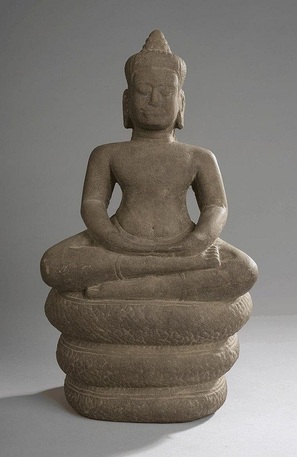
7: Buddhapatra Mudra (Mudra of the Buddha’s Alms Bowl)
This is one of the mudras distinctively identified with Shakyamuni Buddha. Here the two hands are placed horizontally in opposition to hold an actual or figurative begging bowl at the level of the breast, one hand above and the other underneath. In some variations, the bowl is replaced by a wish-granting jewel or by a treasure box.
This is one of the mudras distinctively identified with Shakyamuni Buddha. Here the two hands are placed horizontally in opposition to hold an actual or figurative begging bowl at the level of the breast, one hand above and the other underneath. In some variations, the bowl is replaced by a wish-granting jewel or by a treasure box.

8: Vajra Mudra (Mudra of the Fist of Wisdom)
The Vajra Mudra is typical of Korea and Japan, but is actually unknown in India, so it should perhaps more appropriately be identified by its Japanese name of Chi Ken-in. This specifically tantric symbol is made by enclosing the erect forefinger of the left hand in the right fist.
This gesture is closely associated with Vairocana, one of the five transcendent Buddhas. The mudra stresses the importance of Knowledge in the spiritual world and is also known as the Mudra of Supreme Wisdom. The five fingers of the right hand also represent the five elements protecting the sixth, man. Another interpretation claims that the erect forefinger represents Knowledge, which is hidden by the world of appearances (the right fist). In Tibet, this mudra represents the perfect union between the deity and his feminine power.
The Vajra Mudra is typical of Korea and Japan, but is actually unknown in India, so it should perhaps more appropriately be identified by its Japanese name of Chi Ken-in. This specifically tantric symbol is made by enclosing the erect forefinger of the left hand in the right fist.
This gesture is closely associated with Vairocana, one of the five transcendent Buddhas. The mudra stresses the importance of Knowledge in the spiritual world and is also known as the Mudra of Supreme Wisdom. The five fingers of the right hand also represent the five elements protecting the sixth, man. Another interpretation claims that the erect forefinger represents Knowledge, which is hidden by the world of appearances (the right fist). In Tibet, this mudra represents the perfect union between the deity and his feminine power.
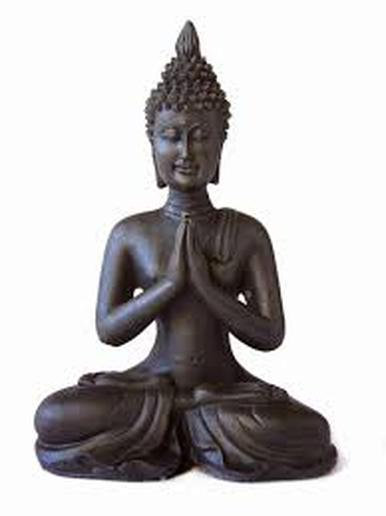
9: Anjali Mudra (The Diamond Handclasp)
The Anjali Mudra is the mudra of offering and devotion. It is formed by joining he hands, which are held vertically at the level of the breast, palm against palm, fingers against fingers, interlocked at the tips, the right thumb covering the left.
The gesture formed by the union of the two hands, recalls the co-existence of the two inseparable worlds, which are really one: the Diamond World, or vajradhatu and the Matrix World, or gharbhadhatu. These two worlds are the expression of two aspects of one cosmic life and represent the reciprocal action of the spiritual and the materials, the static and the dynamic.
As this mudra is a gesture of adoration, giving homage to a superior state, it is never represented on a statue of the Buddha. It is a gesture, which belongs rather to Bodhisattvas and to lesser personages who give homage either to the Buddha or to the dharma. It is frequently seen on multiple-armed Kannon or Kwan-Yin.
Universally used by people in India and South-East Asia for salutation, it evokes an offering of good feelings, of one’s person, etc. and also indicates veneration if it is made at the level of the face. I would like to close with such an evocation to each of you, thanking you for your attention this morning.
The Anjali Mudra is the mudra of offering and devotion. It is formed by joining he hands, which are held vertically at the level of the breast, palm against palm, fingers against fingers, interlocked at the tips, the right thumb covering the left.
The gesture formed by the union of the two hands, recalls the co-existence of the two inseparable worlds, which are really one: the Diamond World, or vajradhatu and the Matrix World, or gharbhadhatu. These two worlds are the expression of two aspects of one cosmic life and represent the reciprocal action of the spiritual and the materials, the static and the dynamic.
As this mudra is a gesture of adoration, giving homage to a superior state, it is never represented on a statue of the Buddha. It is a gesture, which belongs rather to Bodhisattvas and to lesser personages who give homage either to the Buddha or to the dharma. It is frequently seen on multiple-armed Kannon or Kwan-Yin.
Universally used by people in India and South-East Asia for salutation, it evokes an offering of good feelings, of one’s person, etc. and also indicates veneration if it is made at the level of the face. I would like to close with such an evocation to each of you, thanking you for your attention this morning.
